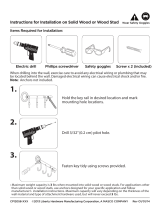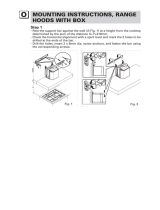
gefi_re you begin--Read these instructions completely and carefldly.
IMPORTANT: Save these instructions for local inspector's use.
IMPORTANT: OBSERVE ALL GOVERNING CODES AND ORDINANCES.
NOTE TO INSTALLER: Be sure to leave these instructions with the (;onsmner.
NOTE TO CONSUMER: Keep these instructions with yore _ Use and (_are Book t()i"
fllture reference.
_!lW'.l;tL'lh'[ell This appliance must be properly grounded. See "Electrical Supply", page 4. i
If wm have questions concerning the installa-
tion of this product, call the GE Answer
Center °' Consmner Intormation Service at
800.626.9000, 94 horn's a day, 7 days a week.
If wm received a damaged vent hood, you
should contact yore" dealer.
CAUTION!
Due to the weight and size of these vent hoods
and to reduce the risk of personal ii_jury or
damage to the product, T_VO PEOPLE ARE
REQUIRED FOR PROPER INSTALLATION.
WARNING!
To reduce the risk of fire or electric shock, do
not use this range hood with any external
solid-state speed control device. Any such
alteration fl'om original thctory wiring could
result in damage to the trait ai'ld/or create an
electrical safety hazard.
To reduce the risk of fire and to properly
exhaust aiI; be sm'e to duct air outdoors. Do
not vent exhaust air into spaces within walls or
ceilings or into attics, crawl spaces or garages.
_\:ARNING: TO REDUCE THE RISK OF FIRE,
USE ONINMETAL DUCT_VORK.
TO REDUCE THE RISK OF FIRE, ELECTRIC
SHOCK OR INJURY TO PERSONS,
OBSERVE THE FOI_LOWING:
A. Use this trait only in the rammer intended
bv the mamlthcturer. If you have arJy q ues-
tions, contact the mamffacturer.
B. Beti)re servicing or cleaning trait, switch
power oil at service panel and lock service
panel to prevent power fl'om being switched
on accidentally. If the service panel cam_ot be
locked, thsten a tag or prominent warning
label to the panel.
For general ventilating use only. Do not use
to exhaust hazardous or explosive materials
and vapors.
Installation work and electrical wiring must be
done by qualified person (s). In accordance
with all applicable codes and standards
including fire-rated construction.
Sufficient air is needed for proper combustion
and exhausting of gases through the flue
(chimney) of tirol burning equipment to
prevent back drafting. Follow the heating
eq uipm ent manuthcturer's guideline and
satiety standards such as those published bv the
National Fire Protection Association (NFPA),
and the American Society for Heating, Refl'ig-
eration and Air Conditioning Engineers
(ASHRAE), and the local code authorities.
Con_n_
Design Information
Models available .................................................................................................................................. 3
Optional Accessories ........................................................................................................................... 3
Product Dimensions & Clearances .................................................................................................... 3
Advance Plmming ............................................................................................................................... 4
Electrical Supply .................................................................................................................................. 4
Installation Preparation
Duct Fittings ....................................................................................................................................... 5
Tools and Materials Required ............................................................................................................ 6
Step 1: Remove the packaging ........................................................................................................... 6
Installation
Step 2: Check Installation Hardware ................................................................................................. 7
Step 3: Mount Template ..................................................................................................................... 7
Step 4: Install Motmting Bracket ....................................................................................................... 8
Step 5: Install the Hood ...................................................................................................................... 8
Step 6: Install Duct Bracket ................................................................................................................. 9
Step 7: Comaect Ductwork ................................................................................................................ 10
Step 8: Cmmect Electrical ................................................................................................................. 10
Step 9: Install Decorative Duct Cover. .............................................................................................. 10
Step 10: Install Filters ........................................................................................................................ 11
Step 11 : Finalize Installation ............................................................................................................. 11













